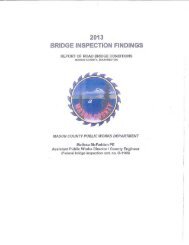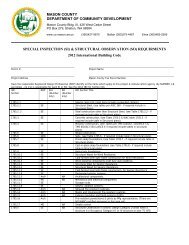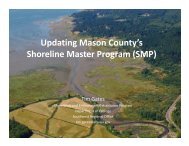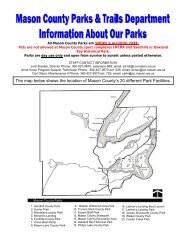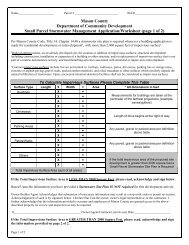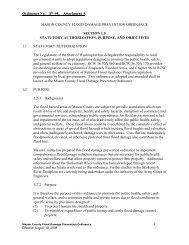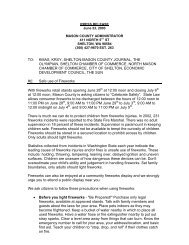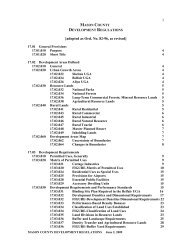Watershed Management Plan - Mason County
Watershed Management Plan - Mason County
Watershed Management Plan - Mason County
Create successful ePaper yourself
Turn your PDF publications into a flip-book with our unique Google optimized e-Paper software.
Appendix<br />
B Key Issues and Options – Water Quantity<br />
Following are options the <strong>Plan</strong>ning Unit and its partners could pursue to<br />
better understand and prepare for the likely effects of climate change in<br />
WRIA 16.<br />
Option 22.<br />
Conduct a modeling and research effort to<br />
predict future hydrographs under climate change<br />
Over the next few decades increasing global and regional air temperatures<br />
are expected to lead to reduced snowpack and receding glaciers. Due to the<br />
dependence of many WRIA 16 streams on snowpack, these changes are<br />
expected to lead to increased winter-time flows, as more precipitation will<br />
fall as rain rather than snow, and decreased spring and summer-time flows,<br />
as snowpack and glaciers are reduced. Furthermore, spring peak flows are<br />
predicted to occur two to six weeks earlier in streams fed significantly by<br />
snowpack. Changes in quantity and timing of flow of this magnitude can<br />
affect the availability of water for all users (particularly agricultural), and<br />
could be detrimental to migrating juvenile salmon, which depend on cool<br />
and ample flows in the late spring for migration. Understanding how global<br />
climate change affects the Pacific Northwest’s climate and water resources<br />
can help watershed planning units more effectively manage water supplies<br />
for current and future water supply needs (UW Climate Impacts Group,<br />
2004).<br />
Accordingly, the WRIA 16 <strong>Plan</strong>ning Unit could partner with an appropriate<br />
scientific organization to conduct a modeling and research effort to predict<br />
more specifically what the streamflow impacts are likely to be. An excellent<br />
resource and potential partner for this effort would be the University of<br />
Washington Climate Impacts Group, which has developed a streamflow<br />
scenario tool to estimate and plan for possible future scenarios (Sniver et al,<br />
2003). The <strong>Plan</strong>ning Unit’s existing stream gauge date would be the starting<br />
point for this effort.<br />
Option 23.<br />
Develop adaptive capacity to efficiently manage<br />
climate impacts on the water supply<br />
One of the likely effects of climate change on WRIA 16 is that reduced<br />
snowpack will lead to lower summer stream flows. In addition, if spring<br />
peak flows occur weeks earlier (as predicted), the time between peak spring<br />
runoff and fall rains may be even longer, further affecting a basin’s ability to<br />
meet water demands during the driest time of year. Finally, warmer<br />
summers may increase demand for water, even as flows are decreasing.<br />
Water conservation, water banking, and greywater use are three strategies<br />
addressed by options presented elsewhere in this plan, but other approaches<br />
may also be needed to extend water supplies into the dry summer months.<br />
In particular, the <strong>Plan</strong>ning Unit could seek to develop adaptive capacity to<br />
prepare for and manage climate impacts. For example, increasing usable<br />
water storage (both surface water and aquifer storage and recovery) can be<br />
an effective means of saving water for summer use. When and if water<br />
page 106 Final <strong>Plan</strong> for <strong>County</strong> Adoption – May 11, 2006



